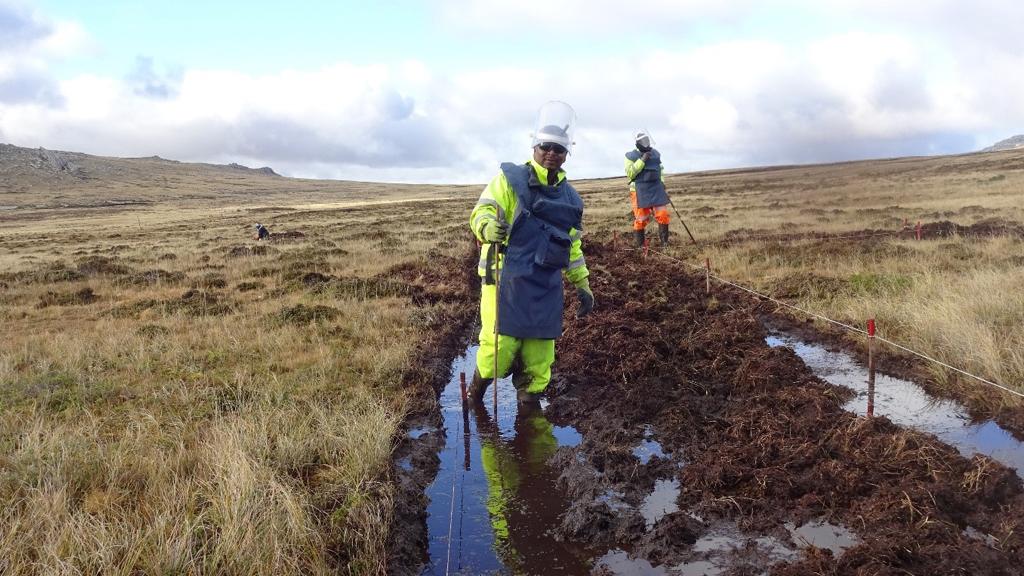The seventy-four days war between the UK and Argentina ended on the 14 June 1982. Thirty-eight years and four months later, on 14 October 2020, the final known landmine was located and removed. This signalled the end of a clearance project which lasted eleven years (from October 2009 to December 2020). Two issues are very briefly mentioned below; firstly, why did it take so long to start the clearance and then the lead up to the clearance.
In 1982 and 1983 after some soldiers were injured clearing mines Mrs Thatcher halted further mine clearance until a safe means of detection was found. Despite research projects over many years seeking a better detection technology especially against minimum metal mines, none materialised. As there was no significant impact on the Islanders – the mines were now behind well signed fences so no Islander was ever injured by a mine – any urgency to clear the minefields was lost. However, a joint feasibility study into the clearance options was commissioned by the UK and Argentina which was published in July 2007. Urgency returned shortly after when States Parties to the treaties which obliged the UK to clear anti-personnel mines and cluster munitions ‘in areas under its jurisdiction or control’ subjected the UK to fierce criticism. At that time there were 122 known minefields.
The clearance project was a complex task for several reasons including, information, logistics, the required quality of clearance, value-for-money and the environment.
- Information about what had been laid by Argentine forces and what had been cleared since the ceasefire by British forces was an initial problem despite Argentine forces having provided some minefield records.
- The sheer distance between the Falkland Islands and the UK: a straight-line distance of 12,985 kilometres made logistics a substantial issue. With a population of only around 3,000, the local infrastructure on the islands was limited restricting the number of project staff that could be accommodated. In addition, some minefields were in remote locations so access to them was problematic.
- Before work started the UK government decided that clearance would be to a very high standard and the measure used was to reduce the risk of mines remaining after clearance to be as low as reasonably practicable (ALARP); a concept used in UK Health and Safety law.
- Having been somewhat reluctant to start clearance in the first place, this shortly after the banking crisis of 2008, demonstrable value-for-money was a key factor and was the cause of many a tense meeting when deciding the best way forward. Ultimately the project had cost the UK £44 million.
- The Falkland Islands are beautiful and the environment was a serious issue. The flora and fauna – especially the penguins – presented challenges as did the sand dunes at Yorke Bay which, in some places, were eight metres above the mines.
The project was undertaken over five phases with the duration and work content predominantly dictated by the availability of funds. Phase 1 was a test on four different types of area to get used to some of the complexities mentioned above. Phase 2 was poorly funded so mine clearance was not possible, but battle area clearance was. Phase 3 was similarly poorly funded only allowing three months’ work which was very poor value for money. Phase 4 was better being undertaken over two years. During Phase 4 the value of a multi-year project gained traction and, still with considerable difficulty, the funding started to become available. Phase 5 was complex partly because the most difficult areas had been left until last. Tasks were arranged in clusters to reduce the movement of staff and equipment. Perhaps a fuller explanation of the project can be presented at another time but suffice to say that despite its myriad complexities, it ended a considerable success. That was down to some very committed people within the company hired to undertake the clearances including the Zimbabwean deminers. The Demining Programme Office (the contractor tasked to undertake external quality assurance and quality control) was critical to the ultimate success. Despite changes of name, and international competitive tendering, the same contractors remained in place for the entire project which was a great advantage to the project. Staff in the Foreign, Commonwealth and Development Office in London also deserve praise for their commitment over the years to battle against the sometimes lack of interest within government.
At the end, over 23,000 km2 of land, 11,621 mines and 22 sub-munitions were cleared with no serious injuries.
Alistair Craib OBE, QGM, MIMCSE
Strategic Advisor to the UK government (2009 – 2020)
